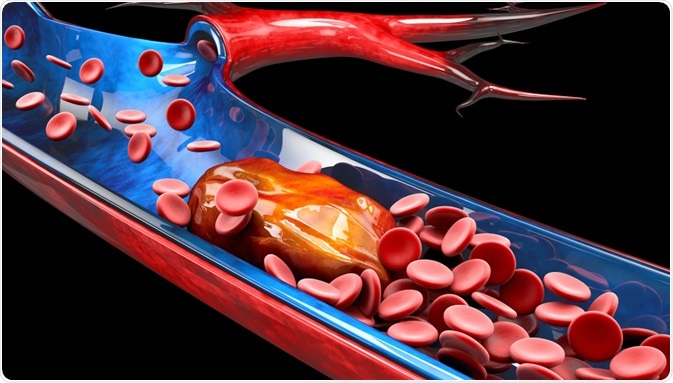In contrast to hemostasis (which is a term used to describe a physiological response that prevents bleeding), thrombosis usually signifies the pathophysiologic formation of a clot or a thrombus. This event may subsequently give rise to life-threatening consequences as a result of either blood flow reduction by the thrombus itself, or by rupture and spread of thrombi, which is also known as embolization.
 Image Credit: Victor Josan/Shutterstock.com
Image Credit: Victor Josan/Shutterstock.com
In the middle of the 19th century, German physician Rudolf Virchow described the repercussions of pulmonary embolus that migrated from the venous circulation, which was later introduced to the medical literature as Virchow’s Triad.
Today, we know that this triad delineates the pathogenesis and etiology of thrombosis and consists of alterations in blood flow (stasis), vascular endothelial injury, and hypercoagulability. It is also used to assess the risk of thrombosis, namely deep vein thrombosis.
High levels of certain coagulation factors and defects in the natural anticoagulants can predispose an individual to thrombotic events. For example, approximately 5% of all Caucasian population has a genetic alteration which makes factor Va resistant to activated protein C. When such variants work concertedly with other risk factors (such as oral contraceptive use), thrombotic risk is even further increased.
Venous thrombosis
The endothelium of blood vessels provides a pivotal role in the prevention of thrombosis, as its surface intercepts the attachment of cells and proteins that are required for coagulation cascade. Healthy and intact endothelial cells express different anticoagulants; contrariwise, when activated, these cells downregulate the expression of thrombomodulin (one of the important anticoagulant proteins) and upregulate tissue factor procoagulant activity.
Furthermore, miscellaneous adhesion molecules are also expressed on activated endothelial cells, such as E-selectin, P-selectin, and von Willebrand factor that capture white blood cells and platelets. In addition, the venous valve sinus is susceptible to thrombosis due to haphazard blood flow patterns and the possibility of low oxygen tension.
Hypercoagulable state is a common term used to describe a plethora of conditions that favor the procoagulant state and arise as a consequence of unbalanced hemostatic mechanisms inclining towards thrombosis. Hence the changes in the hemostatic factors and their defects (most notably antithrombin deficiency and variations in the protein C and fibrinolytic pathways) play a significant role in venous thrombosis.
Inflammation and coagulation (that eventually leads to thrombosis) are closely interrelated, which is supported by the observations that the inflammatory processes are frequently accompanied by activation of blood coagulation and fibrin formation, and that thrombosis almost invariably elicits an inflammatory reaction.
Akin to oral contraceptives, pregnancy also carries an increased risk for venous thrombosis development (which is increased even further in individuals with thrombophilia). Cancer is considered one of the major risk factors for venous thrombosis, as tumors are known to shed membrane particles with procoagulant activity.
Thrombosis : Definition, Causes, Types, Morphology, Fate of a Thrombus & Clinical manifestations
Arterial and microvascular thrombosis
Contrary to venous thrombosis, the activation of coagulation factors does not play a major role in arterial thrombosis, most likely due to their removal by the high flow present in the arteries. Damages in the vessel wall in hypertension or vascular anomalies come into play here, as they can induce turbulence and adjusted blood flow.
Hyperactivity of platelets is also an important factor in the pathophysiology of arterial thrombosis, thus vascular events can be effectively prevented with antiplatelet therapy (for example, by using acetylsalicylic acid). Still, such vascular events are usually presented as stroke or myocardial infarction – a well-known cause of morbidity and mortality around the world.
Thrombosis may also occur in the microcirculation, which should not be neglected as it represents the largest surface area of the body vasculature. The effect of pathologic stimuli on microvascular thrombosis varies according to the vessel type (venules or arterioles), as they show differences in prostacyclin, nitric oxide and von Willebrand factor expression.
In conclusion, thrombosis and thromboembolism represent significant health care problems, and their causes can be both hereditary and acquired. A better understanding of the causes and mechanisms underlying these events is pivotal, as it can provide information for the design of safer and more effective antithrombotic drugs.
References
Further Reading